Canon PowerShot S95
-
-
Written by Gordon Laing
Quality
Canon PowerShot S95 vs Panasonic Lumix DMC-LX5 Real-life resolution (default Program settings)
Canon PowerShot S95 results : Real-life resolution / High ISO Noise
Canon PowerShot S95: JPEG versus RAW
| We photographed the scene pictured above using the S95’s RAW plus Large Fine JPEG mode, allowing us to directly compare images created from exactly the same data. Below are 100% crops taken from the original JPEG file alongside the RAW version, processed with Canon’s Digital Photo Professional 3.9 software; we used the default settings, choosing to apply the Unsharp Mask rather than the basic Sharpness. By default, DPP applied Strength, Fineness and Threshold values of 7, 5 and 2 for the S95’s RAW image. We initially wanted to boost the sharpness to match the crispness of the LX5 sample above, but found increasing any of the Unsharp Mask settings from their defaults produced an artificial-looking image. As such what you see below is as sharp as you can get without beginning to look unnatural. At first glance the results look quite similar with the default settings, but look closely and you’ll spot the in-camera JPEG is a tad sharper with the default settings. That said, there’s fractionally more noise visible on the JPEG, which has been smoothed out on the processed RAW version. Which is better is down to personal preference, but once again applying more sharpening to the RAW file produced a less desirable result in our view. We should also note the saturated sky and snowy areas seen in the image above were completely blown-out, and no amount of adjustment to the RAW file retrieved any of this lost highlight detail. This is a disappointment compared to the Panasonic Lumix LX5, which managed to retrieve a fair amount of previously lost highlight detail from its RAW file, given the same composition and exposure. Of course shooting in RAW on the S95 does give you the benefit of easy adjustment of things like the White Balance, not to mention applying Chromatic Aberration correction, but as far as this particular image was concerned, we saw no real improvement in image quality over the in-camera JPEG. As always though, you may enjoy greater success with different images, settings or even actual RAW converters; the bottom line is while we didn’t see a quality benefit to shooting in RAW for this particular composition, it remains a valuable feature to have at your disposal. Now let’s look at how the camera performs across its sensitivity range in our Canon PowerShot S95 High ISO Noise results. |
Canon PowerShot S95: JPEG | Canon PowerShot S95: RAW | |
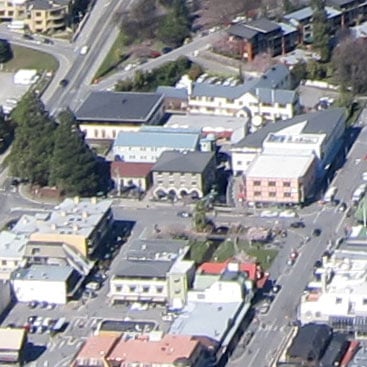 | 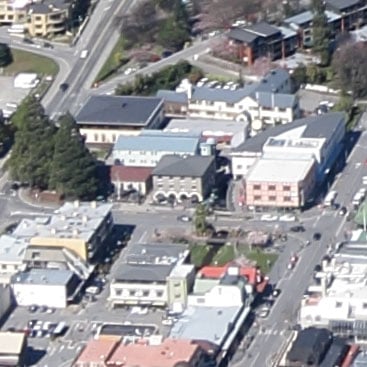 | |
f4, 80 ISO | f4, 80 ISO |
Canon PowerShot S95 results : Real-life resolution / High ISO Noise
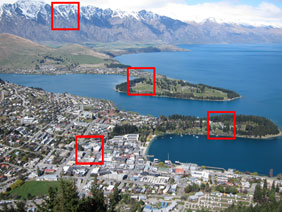 | To compare real-life performance we shot the same scene with the Canon PowerShot S95 and Panasonic Lumix DMC-LX5 within a few moments of each other using their best quality JPEG settings and lowest sensitivities.The lenses were adjusted to deliver as close a field-of-view as possible. Each camera was set to Program mode without intervention to see how they performed with default settings, although we also tested both at every aperture value for reference. |
The image above was taken with the Canon PowerShot S95 at 80 ISO with an exposure of 1/640 and the lens set to 7mm f4; the original file measured 3.10MB. As stated above, we allowed each camera to automatically select its own exposure in Program mode, in order to compare how they performed under default settings. Coincidentally both models selected f4 with an identical exposure of 1/640 at 80 ISO allowing a direct comparison; the Panasonic Lumix DMC-LX5 JPEG measured 4.38MB.
Both cameras share the same 10 Megapixel resolution (so long as the LX5 is set to capture 4:3 shaped images), but the relatively coarse zoom increments on the S95 prevented us from perfectly matching the coverage on this test shot. The S95 sample captured a fractionally wider view and hence its crops show a slightly larger area than those from the LX5, but they’re still sufficiently close for a meaningful comparison.
Before starting though, a quick note about apertures. We additionally tested each camera at a variety of focal lengths with each of their available aperture settings to determine the optimum settings. Both cameras performed respectably at their maximum apertures, but enjoyed a boost in contrast and sharpness across the frame with their apertures closed by a stop. We’d say the optimum settings for each were between f2.8 and f4.0, so are satisfied to use the samples taken in Program at f4 as a fair comparison. Both cameras did however suffer from softening due to diffraction at f5.6 or smaller apertures though, so we’d only recommend using them if you absolutely need the largest depth of field.
Now on with the comparison. Starting with the first row of crops, the Lumix LX5 is clearly delivering a superior result from the mountain ridge with crisper details. Looking beyond this cropped area, the LX5 image also contained a little more tonal detail in the bright sky and snow at times when the S95 image was completely saturated. Since both images were taken within moments of each other and shared the same exposure, this certainly seems to confirm Panasonic’s claims of an improved dynamic range. Don’t get us wrong, it’s not a huge difference, but it is visible and also gives you more margin for highlight recovery on RAW files.
Looking at the rest of the crops, the Lumix LX5 enjoys slightly crisper and more detailed results, which are most apparent on the roads and buildings. Viewed in isolation, the Canon PowerShot S95 image looks very good, but side-by-side with the Lumix LX5, it looks a little soft at times and lacks the ultimate detail of its rival. To be fair, the S95 image below captured a slightly larger area, giving the LX5 a small resolution advantage, but even with this taken into consideration, the LX5 is a little crisper.
It should however be noted the Canon PowerShot S95 suffered from less corner softening at maximum apertures than the Lumix LX5, so it’s not a totally one-sided argument. But in this particular test, the Lumix LX5 enjoys the edge over its rival.
Scroll down to see a RAW versus JPEG comparison, or to check out the performance across its sensitivity range, head straight to our Canon PowerShot S95 High ISO Noise results. Or if you’ve seen enough, head straight to our Verdict.
Canon PowerShot S95 | Panasonic Lumix DMC-LX5 | |
 |  | |
f4, 80 ISO | f4, 80 ISO | |
 |  | |
f4, 80 ISO | f4, 80 ISO | |
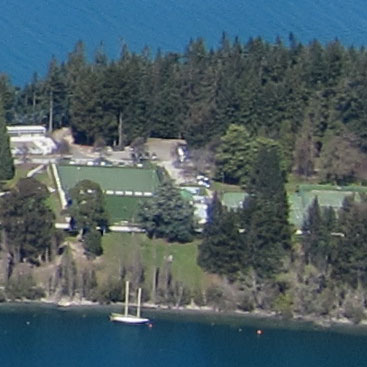 | 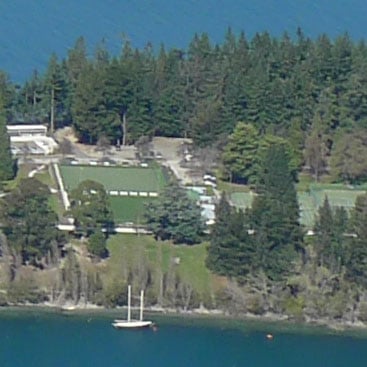 | |
f4, 80 ISO | f4, 80 ISO | |
 | 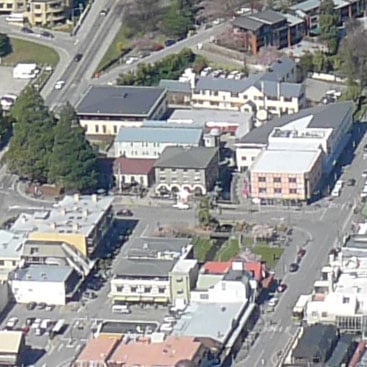 | |
f4, 80 ISO | f4, 80 ISO |
Canon PowerShot S95 vs Panasonic Lumix DMC-LX5 vs Canon IXUS 300 HS / SD4000 IS High ISO Noise
Canon PowerShot S95 results : Real-life resolution / High ISO Noise
Canon PowerShot S95 results : Real-life resolution / High ISO Noise
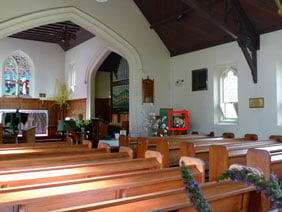 | To compare noise levels under real-life conditions we shot this scene with the Canon PowerShot S95, Panasonic Lumix DMC-LX5 and IXUS 300 HS / SD4000 IS within a few moments of each other using their best-quality JPEG settings and at each of their ISO settings.The lenses were adjusted to deliver as close a field-of-view as possible. Each camera was set to Program to see how they performed with default settings; Intelligent Resolution was disabled. |
The image above was taken with the Canon PowerShot S95 at 80 ISO with the lens set to 7mm (33mm equivalent). The camera was set to Program mode for the sequence below and at 80 ISO selected an exposure of 1/8 at f2.5. The original file measured 1.97MB and the crops are taken from the area marked by the red square. Note contrast and dynamic range enhancers were disabled for this test.
On this page we’ve compared three compact cameras which claim to offer better than average low light capabilities. All three have avoided the Megapixel race and opted for sensible 10 Megapixel resolutions. All three have bright lenses with a maximum f2.0 aperture when zoomed-out. Where they differ though are their sensor sizes. The Canon PowerShot S95 and Panasonic Lumix DMC-LX5 both employ CCD sensors which are approximately the same size. In contrast the Canon IXUS 300 HS / SD4000 IS employs a CMOS sensor that’s a little smaller.
Now the size difference isn’t anywhere near that of a compact versus a DSLR or EVIL camera, but it’s a size difference none-the-less. Since all three cameras share the same resolution, conventional wisdom would therefore suggest the slightly larger sensors in the S95 and LX5 should be a little more sensitive, thereby resulting in lower noise levels. But how much difference can you expect and at what ISO value will the benefit kick-in? Let’s find out.
The Canon S95 and Panasonic LX5 start the sequence at 80 ISO and what’s immediately apparent is a difference in processing styles using the default settings. The S95 has opted for punchier processing with a slightly sharper result, while the LX5 is softer, yet also a little more saturated with some fuzziness on areas of flat colour like the leaves. The LX5 image looks slightly out of focus, but we pre-focused on the target area and repeated the test with the same results.
At 100 ISO, both the S95 and LX5 exhibit fractionally higher noise levels, but they’re barely visible so of no concern yet. Meanwhile the IXUS 300 HS / SD4000 IS joins in at this point with a slightly higher base sensitivity of 125 ISO, and pixel-peepers may notice the slightest hint of greater noise levels on its crop, but again it’s nothing to worry about.
At 200 ISO, all three cameras exhibit slightly higher noise levels than before, but without an compromise in detail. Look closely and the S95 enjoys a slight edge over the IXUS 300 HS / SD4000 IS, but it’s hardly significant. Interestingly the LX5’s noise levels look similar to the IXUS 300 HS / SD4000 IS at this point, giving the S95 a fractional lead at 200 ISO.
With the sensitivity increased to 400 ISO, noise levels have again increased on all three, and while there’s no clear leader in this respect, the IXUS 300 HS / SD4000 IS has begun to soften a little with a slight loss in saturation. Again it’s perhaps not as much as you’d think considering its smaller sensor, but the downhill process has begun.
At 800 ISO though the smaller sensor of the IXUS 300 HS / SD4000 IS is beginning to suffer more than the other two cameras with more visible noise artefacts. The S95 and LX5 are showing roughly the same degree of real-life detail at this point and similar noise levels, but to our eyes the LX5’s artefacts are more electronic-looking, making the S95 the preferred result at this point.
1600 ISO is where the smaller sensor of the IXUS 300 HS / SD4000 IS really struggles with a noticeably fuzzier, noisier and less saturated image than the other pair. Meanwhile the LX5 is applying greater noise reduction by default than the S95 with greater smearing as a result. The S95 shows more visible noise, and it’s really down to personal choice which you prefer. That said, the processing artefacts of the LX5 still look more electronic and less natural than the S95 to our eyes, so again the Canon has the edge.
All three cameras bravely offer a 3200 ISO option at their maximum resolution, but none are looking good at this point. The LX5 then goes on to offer 6400 and 12800 ISO sensitivities but at a greatly reduced resolution of 3 Megapixels. All three cameras additionally offer scene presets with low light conditions in mind. The LX5’s High Sensitivity preset operates at 3 Megapixels and is shown here with an automatic sensitivity of 1600 ISO. The S95 and IXUS 300 HS / SD4000 IS’s Low Light modes both operate at 2.5 Megapixels and here chose sensitivities of 800 and 1000 ISO respectively. Both Canon’s deliver a better-looking result here, but equally they were operating at lower sensitivities.
Despite different strategies in image processing which can be balanced by tweaking the in-camera settings or shooting in RAW, the Canon S95 and Panasonic LX5 essentially deliver similar levels of detail and degrees of noise. Which style you prefer is entirely personal, although we felt the S95 looked more natural when noise became more obtrusive and also enjoyed a fractional advantage in cleanliness.
The really interesting result for us though is how well the IXUS 300 HS / SD4000 IS performed given its slightly smaller sensor. You’d be hard-pushed to notice much difference up to 400 ISO, and the size deficit only really becomes a big issue at 1600 ISO. So the LX5 and S95 only really enjoy a significant advantage – in this test anyway – above 800 ISO. If you want much cleaner results at high sensitivities you’ll simply need the much larger sensor of a DSLR or mirror-less EVIL camera. Indeed you may wish to compare these results with those from the Canon EOS 60D and EOS 50D which were taken during the same session, just moments apart – see our Canon EOS 60D High ISO Noise results page.
Check out our PowerShot S95 Sample Images Gallery for more examples across the sensitivity range, or if you’ve already seen enough, head on over to our verdict!
Canon PowerShot S95 | Panasonic Lumix DMC-LX5 | Canon IXUS 300 HS / SD4000 IS | ||
 |  |  | ||
80 ISO | 80 ISO | 80 ISO not available | ||
 |  |  | ||
100 ISO | 100 ISO | 125 ISO | ||
 |  |  | ||
200 ISO | 200 ISO | 200 ISO | ||
 |  |  | ||
400 ISO | 400 ISO | 400 ISO | ||
 |  |  | ||
800 ISO | 800 ISO | 800 ISO | ||
 |  |  | ||
1600 ISO | 1600 ISO | 1600 ISO | ||
 | 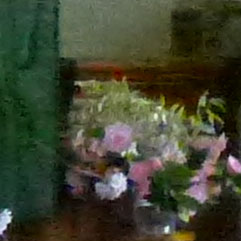 |  | ||
3200 ISO | 3200 ISO | 3200 ISO | ||
 |  |  | ||
6400 ISO not available | 6400 ISO | 6400 ISO not available | ||
 |  |  | ||
12800 ISO not available | 12800 ISO | 12800 ISO not available | ||
 |  |  | ||
Low light preset (2.5 Mpixels / 800 ISO here) | High Sensitivity preset (3 Mpixels / 1600 ISO here) | Low light preset (2.5 Mpixels / 1000 ISO here) |




